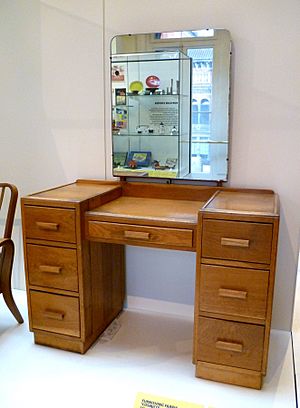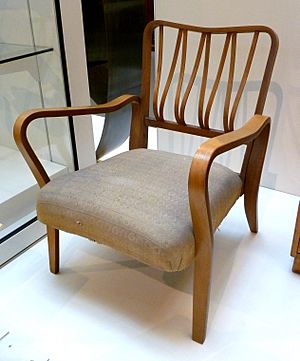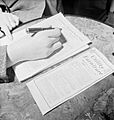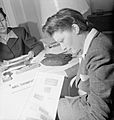Utility furniture facts for kids

Utility furniture was a special type of furniture made in the United Kingdom during and right after World War II. The government created a plan to make this furniture. This was because there weren't enough materials like wood. Also, many things were rationed (meaning you could only buy a small amount). The Utility Furniture Scheme started in 1942. It continued during the tough times after the war and ended in 1952.
Contents
Why Utility Furniture Was Needed
By 1941, there wasn't much wood left to make furniture. Many homes were also destroyed by bombs during the war. At the same time, many new families were starting. All these things meant there was a big shortage of furniture.
The Utility Furniture Advisory Committee
In 1942, a group called the Utility Furniture Advisory Committee was formed. Their job was to make sure that the limited materials were used wisely. Famous designers like Gordon Russell were part of this group.
New furniture was rationed, just like food. Only people who had just gotten married or whose homes were bombed could buy it. This rule started on November 1, 1942.
Utility furniture used a special logo. It was the same logo used for utility clothing. It had two capital 'C's and the number 41. This stood for "Controlled Commodity 1941." People soon called it "the two cheeses."
The Utility Furniture Catalogue
The committee created special designs for furniture. These designs were put into a book called the Utility Furniture Catalogue in 1943. The goal was to make strong, well-designed furniture. It also had to use wood very carefully.
The designs were simple and didn't have much decoration. This was different from the fancy furniture people liked before the war. The designs were inspired by the Arts and Crafts movement. About 700 companies across the country made furniture based on these designs. The quality of the furniture could be different between makers.
In 1943, the committee changed its name to the Utility Design Panel. Gordon Russell became its chairman. In 1946, the panel showed off three new furniture collections. They wanted to display their ideas for post-war design. This happened at an exhibition called "Britain Can Make It."
The End of Utility Furniture
The designers believed their simple furniture looked good. However, people started wanting more decorative furniture. Some even added decorations to their utility furniture illegally.
In 1948, the design rules became less strict. A new collection called "Diversified" was announced. These designs were influenced by modern Scandinavian design. But most people still didn't like the simple style. So, the panel was eventually closed down. The Utility Furniture Scheme officially ended in 1952. This was also when furniture rationing stopped.
Gallery








